Student Blog
What are OS/OT?
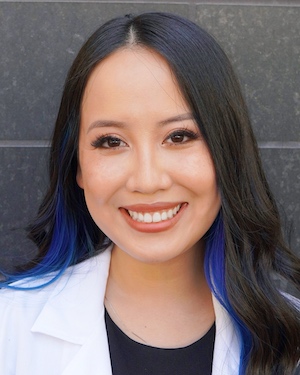
8 things I 8 this year that I used to love, but now h8 ⟩
December 22, 2021, by Teresa
Life Hacks What are OS/OT?
As we heard more and more about a novel “coronavirus” with each day, I was working full-time as a rehab aide at a nursing home — which at the time, were severely ill-equipped to handle a pandemic with respect to manpower and physical resources. One morning in April 2020, I woke up for another day of work when I realized that overnight, I had been robbed of 2 out of the 5 primary ways I interact with this world.
The anosmia (loss of smell) and ageusia (loss of taste) lasted about 3-4 weeks, but fast forward to 20 months later, nearly TWO YEARS, and I still experience parosmia and dysgeusia, which means those 2 senses returned but that my perception of how things taste and smell is incorrect compared to my memory of them. So without further ado, here are 8 things I have consumed during this pandemic that I used to love, as well as some tips and tricks I’ve picked up along the way so I can continue to enjoy them as I adapt to this new and strange sensory experience.
- I’ll start off with the one that makes me saddest — potatoes 🥔. Yup, that wonderful versatile vegetable. Like a diamond, she thrives under pressure — she can be mashed, she can be fried, she can be baked and loaded. We all know and love her! My comfort food was always french fries, so you can imagine my disappointment when my teeth first pierced through that crispy exterior and I immediately wanted to spit it back out. Where I used to taste salty, crunchy goodness, I now perceive an enhanced chemical flavor of starch. My workaround? Sweet potato fries! My perception of sweet foods didn’t change much, so sweet potatoes still taste the same and even though it’s not exactly the same, I still get the oral gratification from the textures.
- Speaking of enhanced chemical flavor, you know that very distinct artificial banana flavor they put in candy, like with banana-flavored Laffy Taffy? Well, all bananas 🍌 taste like that to me now. While it’s not the same, I am reminded of what a banana used to taste like when it’s mixed among other fruits, like in a smoothie or açaí bowl! The banana flavor is still most prominent in those mixtures, but the “artificial” flavor is dampened some by other fruits, yogurts, and juices.
- If I could only have one food for the rest of my life, it would be either phở or tacos but an essential garnish to both is onion. However, I can tell the distortion of onion is resolving with time because at first, the smell of it was unbearable and truly smelled like the secretion from axillary nodes (aka B.O. 😅) but now, if I cook the onion slices before adding it to my bowl of phở or ask the taquero for grilled onions instead, I’m still able to enjoy my favorite foods.
- Along with #3, garlic is a staple in Asian cuisine. Growing up, I knew I needed to finish up my homework soon the moment the delicious smell of garlic filled the house because it meant my mom was about to complete the last step of dinner: sautéing vegetables. I remember the stunned look on my mom’s face as I regained my senses when I entered her kitchen and went, “What’s that awful smell?!” to which she responded, “. . . I was making your favorite, garlic green beans.” But luckily, as with onion, this is something that seems to be resolving with time as well.
- I touched on this a bit earlier, but fried foods . . . and that includes chips. This has been a tough one because I love the feeling of a good *crunch*. My workaround? SAUCES! Using my favorite sauces, while discovering new ones in the process, has been such a blessing and helps mask the distorted tastes.
- You may have heard of this one: meats. What you might not know is that the distortion can happen on a spectrum. For me, chicken 🍗 tastes the most similar to before and is the least pungent. Then comes beef, which I can’t stand to eat on its own, like as a steak 🥩, but still tastes gr8 within a mixture of other flavors, like in a burger! The most pungent taste is pork 🥓, which has been a difficult workaround because so many recipes in my culture call for a pork-based broth.
- Not that I (will admit I) eat this, but an honorable mention is toothpaste, since it was my first indicator which alerted me to immediately self-isolate and prevented me from spreading it to my loved ones. Shout out to toothpaste, making your BADLs and COVID prevention possible since 1824! Toothpaste companies–feel free to recruit me for your next marketing campaign. Move aside, “recommended by 9 out of 10 dentists,” “potential early coronavirus detection tool” coming through! In all seriousness, all toothpaste tastes like what onion used to taste like, while mint and mint-flavors still taste the same. This COVID symptom is most mysterious, indeed.
- And last but definitely not least, coffee ☕. Every cup of coffee I’ve had in the last 20 months tastes burnt but I’ve found that using a dairy alternative really helps. My favorite has been oat milk, because its strong flavor overpowers and masks the burnt taste really well. However, I’ll let you in on the true caffeinated nectar of life which has sustained this tired graduate student so far–Guayaki’s organic yerba mate, but ONLY the flavor Enlighten Mint and ONLY in the can, NOT the bottle. Thank me later.
This experience, while something I would never wish upon anyone, deepened my appreciation for occupational therapy. The child labeled as a picky eater, the adult whose high perceived pain has them labeled as a malingerer, the older adult who resists polypharmacy . . . We are unable to fully understand other people’s very subjective experiences, so we cannot say with absolute certainty that there is one right way to experience this world. As OTs, we approach this subjectivity by making our care occupation-based. We make it client-centered, in order to figure out how to best meet unique needs and experiences.
The way we taste and smell is so closely tied to how we engage in our occupations and in life, in regards to nutrition, mindful eating, social participation, weight management, and mental health. But in a similar way to our perceived sensations, time is also subjective. I started something called “smell retraining therapy” and was often frustrated at how little my sensory gains were in comparison to the literature and testimonials. But I continue to remind myself that recovery is not linear and everyone’s trajectory will look different, including my own, so instead of rushing my progress, I’ve come to appreci8 the process.
(But still, the return of 🍟 could not come sooner.)
⋯
My Experience with the Pen Pal Program ⟩
December 13, 2021, by Global Initiatives Team
International What are OS/OT?
By Abraham Ramirez, Entry-Level Professional Master’s student
Editors Alison Chang and Vanessa ElShamy
Entry-Level Professional Master’s students

Abraham Ramirez
One of the meaningful projects that I’ve been involved in within Global Initiatives is the Pen Pal Program. I was lucky enough to be connected to two students in Colombia who were both in the same year at the Escuela Colombiana de Rehabilitacion. This was a great opportunity to learn about occupational therapy and its scope of practice in Colombia. My pen pals and I communicated in Spanish because it’s the most widely spoken language there.
What is the most memorable letter that you’ve received from your pen pal?
Even though the program has the word “pen” in the title, my pen pals and I decided to communicate through Instagram messenger via group chat, as well as Zoom when we found the time. Our group chat conversations revolved mostly around the OT profession in our respective countries. However, the most meaningful experience was communicating over Zoom. We talked a lot about differences in culture between Mexicans and Colombians, since I’m culturally Mexican. We also discussed nuances in Spanish and how the language has evolved in Colombia and Mexico. It was interesting to find the beauty in the uniqueness of our cultures, as some may make assumptions that countries in Latin America are all similar.
What is the best thing you have learned from your pen pal?
I learned about how OT education is different in Colombia compared to in the U.S. In Colombia, you currently only need a bachelor’s degree to practice as an OT. Additionally, from the way they explained their curriculum, it seemed like there’s an emphasis on hands-on approaches. I also like that they place emphasis on OT in the “sector laboral,” or “the workplace.” For example, one of my pen pals had a rotation at an airport where she completed ergonomic assessments for the personnel.
What message would you send to your pen pal right now if you had only 2-3 sentences to say it?
If I were to send a message to my pen pals right now, I would honestly just say that I appreciate their openness to friendship, even though there are hundreds of miles between us. It’s great to know that there’s people across the world that enjoy speaking with you.
⋯
My Experience in Creating the World OT Day Video for the USC Chan Division ⟩
November 29, 2021, by Global Initiatives Team
Diversity International Videos What are OS/OT?
By Kashvi Shah, Post-Professional Master’s student
Editors Michelle Plevack and Abraham Ramirez
Entry-Level Professional Master’s students
“Our sense of belonging can never be greater than our level of self-acceptance.” — Brené Brown.
At USC Chan, we have a diverse global community with a significant percentage of international students. Most of them struggle to find their sense of belonging in this new environment and find it challenging to develop resilience. However, “true belonging does not require you to change who you are: it requires you to be who you are” (Brené Brown).
Hence, on this World OT Day, I thought it would be a great idea to involve our student community in celebrating ourselves and our profession. I approached Dr. Daniel Park at the Global Initiatives office with the idea of creating a short video film of our students on the theme by WFOT (World Federation of Occupational Therapists): Belong, Be You. I am sure you began to wonder what these words mean to you. And so did I.
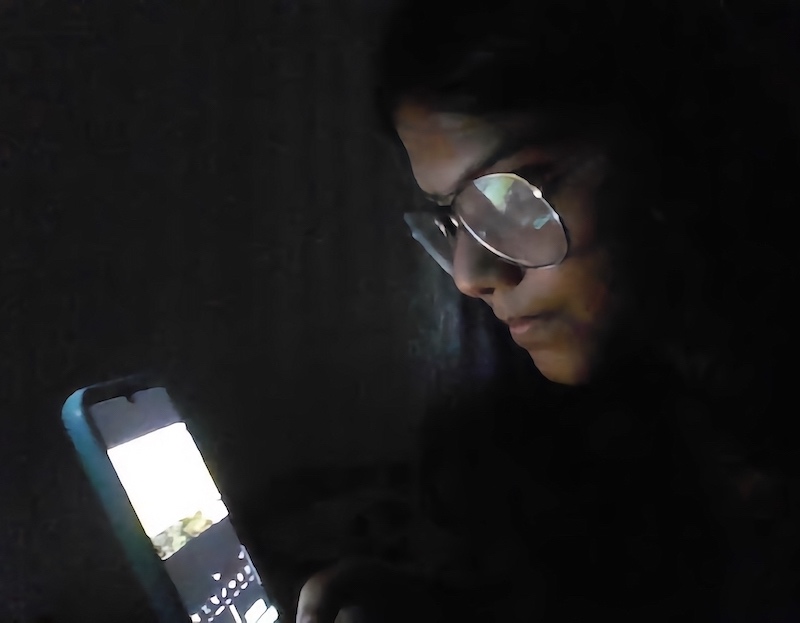
Kashvi in the process of World OT Day video editing
Earlier, I was excited about this project as I found an opportunity to contribute to this with my interest in videography and editing. However, soon after my excitement turned into anxiety. The technical aspects of videography then seemed less challenging than the conceptualization of this video, which was more entangled than expected.
Fortunately, I had the assistance of Marvyn Ngo, our MA-1 Student Ambassador at USC Chan, who always corroborated my ideas and furthermore, helped in reaching out to students for participation in the video.
The most exciting and enthralling part of this process began next, as it was finally time to put together what the participants had shared. Ann Beattie once said “People forget years and remember moments.” That is exactly what the video clips from our participants’ cherished moments were. They could feel their belonging in celebrating who they really are! I enjoy dancing as a meaningful occupation wholeheartedly and being myself is my true belonging. I was glad to see how all our participants found meaning in different activities.
For me this experience was so enriching. From facing the challenges of generating ideas to the support in executing them, and from the excitement of creation to the anxiety of outcome, it was indeed a whirlwind. For this opportunity, I am grateful to those at the Chan Division who added meaning to my belonging at USC.
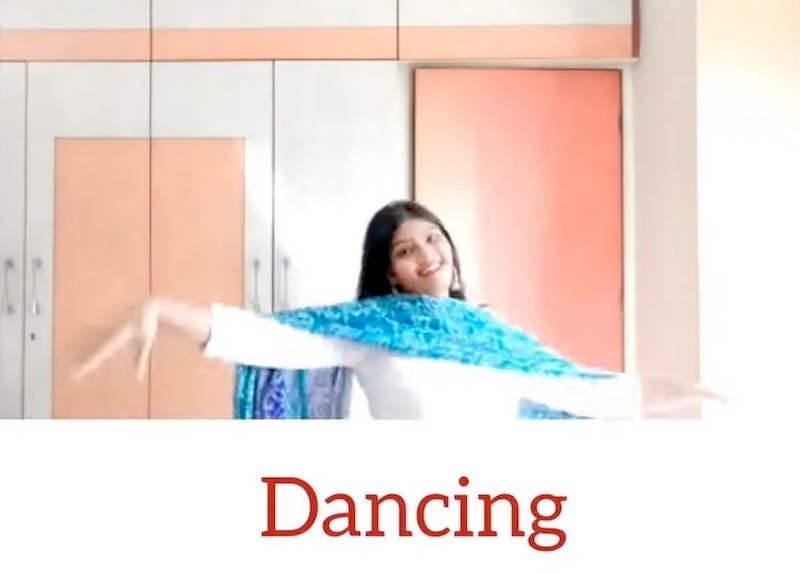
Kashvi enjoying dance, Being herself!
References
Brown, B. (2012). Daring greatly: How the courage to be vulnerable transforms the way we live, love, parent, and lead. New York, NY: Avery.
Brown, B. (2017). Braving the wilderness: The quest for true belonging and the courage to stand alone. New York, NY: Random House.
Beattie, A. (2002). Where you’ll find me and other stories. New York, NY: Scribner.
⋯
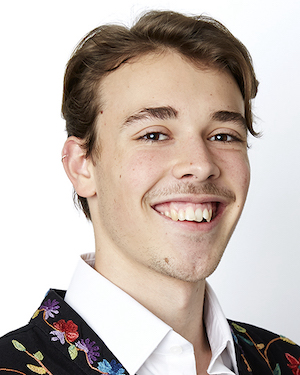
From Inside of Your Mind to Outside of Your Closet: Making a Case for Dressing ⟩
November 22, 2021, by Seth
Diversity What are OS/OT?
We all know that a good dressing can make or break a salad, but what can it do for your day? No, I’m not talking about dousing yourself in ranch, Italian, or even a tasteful balsamic vinaigrette, this blog is about clothes! The American Occupational Therapy Association’s Occupational Therapy Practice Framework (OTPF): Domain and Process (4th ed.; 2020) defines dressing as:
Selecting clothing and accessories with consideration of time of day, weather, and desired presentation; obtaining clothing from storage area; dressing and undressing in a sequential fashion; fastening and adjusting clothing and shoes; applying and removing personal devices, prosthetic devices, or splints. (p. 30)
When I am asked about dressing, however, I simply define it as one of my favourite occupations.
We all know the basics: is it hot outside? Put on a t-shirt. Is it time for bed? Time for pajamas! Do you have an interview later today? Gotta wow them with your best business casual. Some people may find these decisions a chore, as something that takes up those precious moments in the morning that you could instead use to snooze your alarm. It could even be that you may be one of these people, but I often think that there are a lot of missed opportunities when it comes to dressing and I’m here to push the envelope. Although AOTA’s definition is dynamic, two parts stand out, two parts that open the door for this conversation, and those are “consideration” and “desired presentation.”
The Black
I have to admit that it took me some time to understand the nuances of what “desired presentation” really meant. To set the scene for you, I want to take you on my personal journey with the occupation of dressing. If a stranger looked at me in high school, they would probably describe my sense of style as “prep.” Without fail you could spot me in a neutral or plaid button-up shirt with sleeves cuffed to the forearm over a standard pair of khakis. I woke up every morning, donned a variation of this outfit, and walked out the door without a second thought. When I look back at that time, however, I think that by dressing in preppy I was actually prepping for a day that I thought would change everything; the day I came out as gay. I thought that if I made the way I looked more palatable and if I blended in more that when the day came, people wouldn’t be so quick to reject me. That they’d at least think twice about it. It turns out that every seemingly unconscious dressing decision I made considered that outcome and I so desperately wanted it to not be the case.
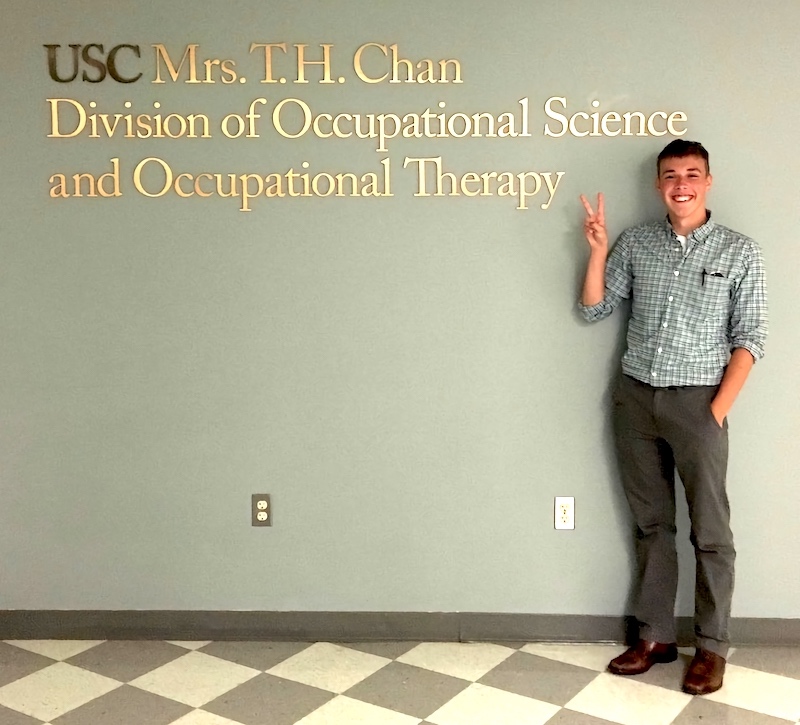
High School Seth before the first week of classes at USC in August 2017, AKA photographic evidence of the aforementioned button-up, cuffed sleeves, and khakis.
The White
Things began to change my senior year when I realized that that time in my life was coming to an end. Graduation was on the horizon and I began to loosen my collar, wear some jeans every once in a while, and add some colour into the rotation. Then came the news that I was admitted to USC’s BS-MA program and, although it was months before the semester started, my mind was already in LA. What was I thinking about? That a new place meant a new me, and even more importantly, a new wardrobe. I started to go thrifting and over time, with the support of my lovely community, I decided to let the world know I was capital G-A-Y, GAY! When I got dressed in the morning, this was the desired presentation I coordinated everything around. USC just had to know. Talk about a complete 180°.
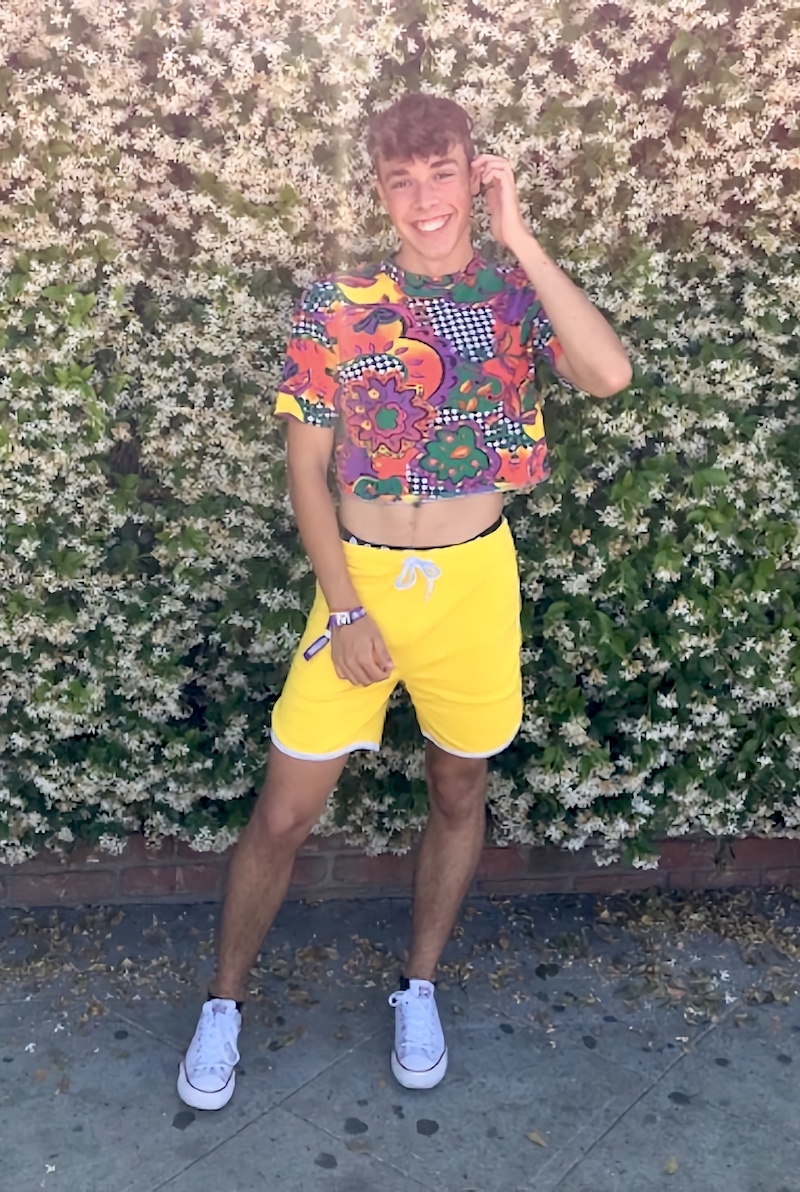
First-Year Seth at his first LA Pride, June 2018. To this day, I stand by this outfit.
And All the Colours In-Between
As the years have passed, and as I’ve grown with my intersectional identities, the way I dress has grown with me and now lies somewhere in the middle of that spectrum. I think the single-driving force that informs how I dress is not what I want for others to see, but what I want for myself. On a cloudy day, I’ll bring my own sunshine by wearing my brightest outfit. As the leaves start to change colours, I’ll camouflage myself to match.
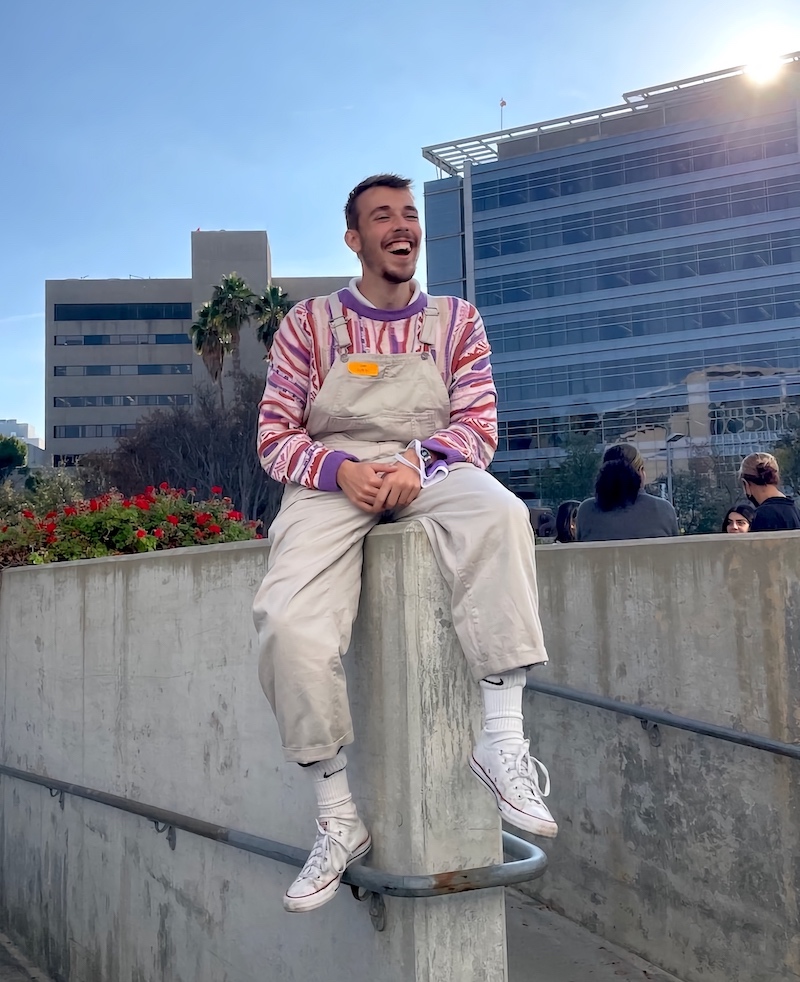
Me this semester, November 2021, comfy and coordinated down to a lavender mask.
I’ve found that weather and time can only change so much, but what I feel when I wake up in the morning is always something new. It’s this uncertainty that makes dressing exciting to me. It’s how one day a shirt can convey one message, but the next day when paired with a different pair of pants it says something totally different. Although what I consider may seem to be more considerate of myself, I want to highlight, however, that High School Seth was just as authentic as First-Year Seth who is just as authentic as the Seth I present to the world now. The one thing that they all have in common, and the thing we all have in common regardless of our identities, is that in each stage there was an intention for a specific desired outcome. Although this blog shares my story, it by no means is meant to capture anyone else’s. That being said, we all get dressed and we all make decisions while doing so. I invite you to take a closer look at the dressing decisions you make, and who knows, you may even help a client do the same in your future practice! Here are some questions to help guide you as you embark the journey to making dressing one of your favourite occupations too:
- What is your intention for the day and what ways do you desire being perceived? How can you align the two?
- Do the clothes you chose match how you feel? Or do they reflect how you want to feel? How does the way you dress support your social and emotional health? Think style with a side of self-fulfilling prophecy!
- How does dressing interact with other occupations? Does it influence your social participation? What’s its relationship with hygiene and grooming occupations?
- I shared how I use dressing to express my identities, do you use dressing to express yours? If yes, which and how?
- Who says dressing can’t be leisure or play! If today was a costume party, what theme would you dress for?
And lastly, it’s a new day, what do you want to put out into the world?
⋯
Reconnecting with my Filipino Roots at USC Chan ⟩
November 15, 2021, by Global Initiatives Team
International What are OS/OT?
By Abby Khou, Entry-Level Professional Master’s student and Global Initiatives volunteer
Editors Alison Chang and Vanessa ElShamy
Entry-Level Professional Master’s students
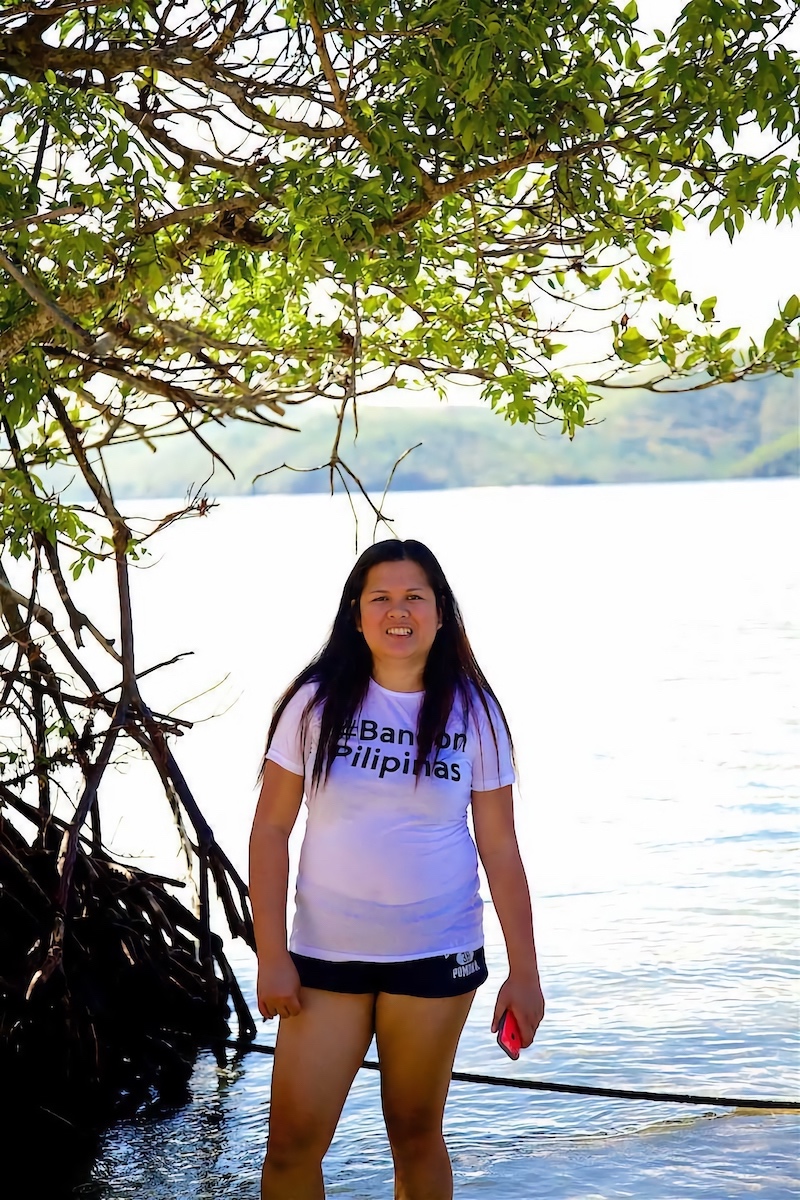
Abby’s visit to Palawan, Philippines
When I first came to the United States as a Filipino immigrant in 1999, I didn’t realize that one of the questions I would be asked the most is “are you a nurse?” While it is one of the popular Filipina stereotypes, it does hold some grain of truth — many Filipino men and women come to the US and either study nursing or work as nurses. In Filipino culture, healthcare workers are held in high regard. I would hear some of my family members boast of their children who work in the medical field or are the pride of their families because of their line of work. Why do Filipinos make such good healthcare workers? I may sound a tad bit biased — my mom is a nurse in Pennsylvania and my dad is a doctor in the Philippines! 😊 I believe that Filipinos are intuitively compassionate, caring, and selfless. They go out of their way to make other people feel comfortable, even when they’re sacrificing their own comfort.
It seems almost inevitable that I would end up pursuing a healthcare career, but I never thought it would be Occupational Therapy. I didn’t see myself as a nurse because I was always a bit anxious when I would get blood drawn. I only found out about OT 4 years ago because of my son’s Autism Spectrum Disorder (ASD) diagnosis. Being a big proponent of Early Intervention, I learned about OT as a parent sitting in on his OT sessions and conversing with his OTs in his Early Intervention program and outpatient pediatric clinic. His OTs made such a big impact in his growth and development that I decided I wanted to do for others what my son’s OTs had done for him. I had been working in public relations and marketing since 2007. In Manila, I was working at a TV network in 2001 and had no idea OT even existed. OT in the Philippines was at its infancy in 1917 when the Philippines’ government enacted the Revised Administrative code, which ensured that those who were injured while serving the government were compensated for ensuing disability and/or injury while serving. OT was introduced to the Philippine Civil Administration Unit I (PCAU I) General Hospital by Andre Roche, an OT of French origin. Similar to in the U.S., OT in the Philippines had its roots in the World War — the purpose of PCAU I was to care for Filipinos and Americans who were impacted by WWII.

Palawan, Philippines
Now in 2021, as a Filipino-American and non-traditional OT student who is pursuing the profession as a second career, I am grateful for the opportunity to connect with my Filipino roots at USC Chan. OT is quickly becoming a sought-after career in the Philippines, and I have met quite a number of Filipino international students pursuing their Post-Professional MA degrees in OT. Two kababayans (fellow Filipinos) were my instructors as OTD residents in the summer and fall. One great interaction I had was with Jerzl Awit, who is the OTD resident for our Quantitative Research class. I attended her workshop for my Literature Search paper and connected with her during the session because we both speak Tagalog (the primary Filipino language). I also met Nicole Parcon, an MA-1 student from the 2021 SOTI Program and exchanged emails with her after we met on Zoom. Now, she is a friendly face that I often bump into and chat with on campus. The sound of Tagalog in the hallways of USC Chan always brings me back home, and the connections I have already made feel like the comfort of warm sabaw (soup) on a cold, rainy day. I am proud of my Filipino colleagues who passionately pursue their OT degrees at USC Chan as part of their journey to becoming an OT practitioner.

Abby’s visit to Palawan, Philippines
⋯





